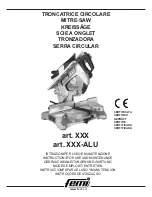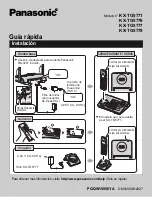
14
English
b. Cutting through material supported at the outer ends
only can cause kickback. As the material weakens it sags,
closing down the kerf and pinching the blade (Fig. L).
c. Cutting off a cantilevered or overhanging piece of
material from the bottom up in a vertical direction
can cause kickback. The falling cut off piece can pinch
the blade.
d. Cutting off long narrow strips (as in ripping) can cause
kickback. The cut off strip can sag or twist closing the kerf
and pinching the blade.
e. Snagging the lower guard on a surface below the
material being cut momentarily reduces operator
control. The saw can lift partially out of the cut increasing
the chance of blade twist.
2.
iMPROPER DEPTh OF CUT sETTing On sAW
a. To make the most efficient cut, the blade should protrude
only far enough to expose one‑half of a tooth as shown
in Figure F. This allows the shoe to support the blade and
minimizes twisting and pinching in the material. See the
section titled
Depth of Cut Adjustment
.
3.
BlADE TWisTing (MisAlignMEnT in CUT)
a. Pushing harder to cut through a knot, a nail or a hard
grain area can cause the blade to twist.
b. Trying to turn the saw in the cut (trying to get back on
the marked line) can cause blade twist.
c. Overreaching or operating the saw with poor body
control (out of balance), can result in twisting the blade.
d. Changing hand grip or body position while cutting can
result in blade twist.
e. Backing up the saw to clear blade can lead to twist.
4.
MATERiAls ThAT REQUiRE EXTRA ATTEnTiOn
a. Wet timber
b. Green timber (material freshly cut or not kiln dried)
c. Pressure treated timber (material treated with
preservatives or anti‑rot chemicals)
5.
UsE OF DUll OR DiRTY BlADEs
a. Dull blades cause increased loading of the saw. To
compensate, an operator will usually push harder which
further loads the unit and promotes twisting of the blade
in the kerf. Worn blades may also have insufficient body
clearance which increases the chance of binding and
increased loading.
6.
liFTing ThE sAW WhEn MAKing A BEVEl CUT
a. Bevel cuts require special operator attention to proper
cutting techniques – especially guidance of the saw. Both
blade angle to the shoe and greater blade surface
in the material increase the chance for binding and
misalignment (twist) to occur.
7.
REsTARTing A CUT WiTh ThE BlADE TEETh JAMMED
AgAinsT ThE MATERiAl
a. The saw should be brought up to full operating speed
before starting a cut or restarting a cut after the unit has
been stopped with the blade in the kerf. Failure to do so
can cause stalling and kickback.
all warnings and precautions as well as proper
operation of the saw. Check the lower blade guard
for proper closing before each use. If the lower blade
guard is missing or not working properly, have the
saw serviced before using. To assure product safety
and reliability, repair, maintenance and adjustment
should be performed by an authorized service center
or other qualified service organization, always using
identical replacement parts.
Checking the Lower Guard (Fig. A)
1. Turn tool off and disconnect from power supply.
2. Rotate the lower guard retracting lever
6
from the fully
closed position to the fully open position.
3. Release the lever and observe the guard
7
return to the
fully closed position.
The tool should be serviced by a qualified service center if it:
• fails to return to the fully closed position,
• moves intermittently or slowly, or
• contacts the blade or any part of the tool in all angles and
depth of cut.
Blades
WARNING:
To minimize the risk of eye injury, always
use eye protection. Carbide is a hard but brittle
material. Foreign objects in the workpiece such as wire or
nails can cause tips to crack or break. Only operate saw
when proper saw blade guard is in place. Mount blade
securely in proper rotation before using, and always use a
clean, sharp blade.
WARNING:
Do not cut metal, plastic, concrete, masonry
or fiber cement materials with this saw.
184 mm Diameter
190 mm Diameter
Application
Teeth
Application
Teeth
Rip
24
Fast rip 1
8
General Purpose
36
General Purpose
24
Finish
60
Finish
40
If you need assistance regarding blades, please contact your
local
D
e
WALT
dealer.
Kickback
Kickback is a sudden reaction to a pinched, bound or misaligned
saw blade, causing an uncontrolled saw to lift up and out of
the workpiece toward the operator. When the blade is pinched
or bound tightly by the kerf closing down, the blade stalls and
the motor reaction drives the unit rapidly back toward the
operator. If the blade becomes twisted or misaligned in the cut,
the teeth at the back edge of the blade can dig into the top
surface of the wood causing the blade to climb out of the kerf
and jump back toward the operator.
Kickback is more likely to occur when any of the following
conditions exists.
1.
iMPROPER WORKPiECE sUPPORT
a. Sagging or improper lifting of the cut off piece can cause
pinching of the blade and lead to kickback.
Содержание DCS573 Series
Страница 1: ...DCS573 ...
Страница 3: ...1 Fig A Fig B 1 2 12 11 15 9 5 7 8 6 13 10 3 14 13 3 13 3 20 ...
Страница 4: ...2 1 2 8 19 18 29 31 30 32 4 10 34 35 32 33 38 Fig D Fig C Fig F Fig E Fig H Fig G XXXX XX XX 16 ...
Страница 5: ...3 9 25 12 Fig J Fig I Fig K Fig M Fig L Fig N 23 22 ...
Страница 6: ...4 12 24 37 4 36 37 24 26 27 28 Fig P Fig O Fig R Fig Q Fig S ...
Страница 40: ...38 Pусский ...
Страница 41: ...39 Pусский ...
Страница 59: ...57 Українська ...
Страница 60: ...58 Українська ...
Страница 61: ......
Страница 62: ......
Страница 63: ......
Страница 64: ...530915 75 RUS UA 03 21 ...
















































